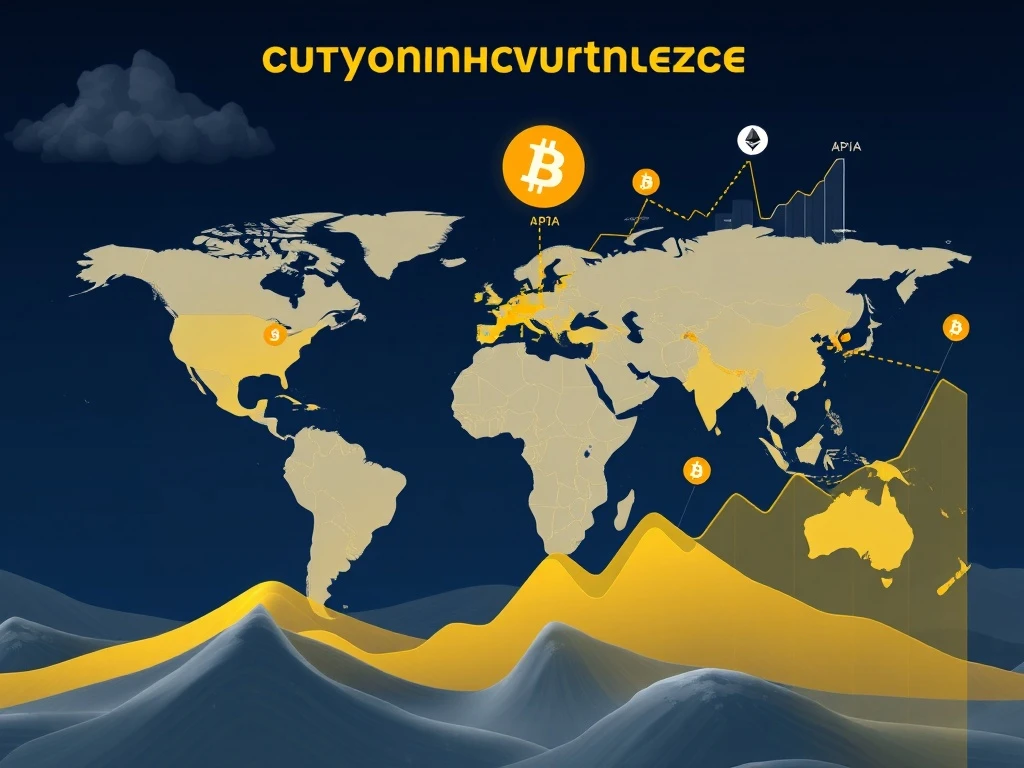Global Crypto Adoption Surges: US Climbs to Second, APAC Shows Remarkable Growth

Interest in cryptocurrencies continues its upward trajectory globally. A new report reveals significant shifts in the landscape. The United States has made a remarkable leap, climbing to second place in worldwide crypto adoption. This move highlights a pivotal moment for digital assets in mature markets. Meanwhile, India maintains its top position, underscoring its enduring influence. This analysis by Chainalysis offers crucial insights into the evolving digital economy.
Unpacking the Latest Chainalysis Report Findings
The 2025 Global Adoption Index from Chainalysis provides a detailed look at the global crypto landscape. Brayden Lindrea’s report highlights key findings. The US now ranks second, a significant jump from its previous fourth position. India, conversely, holds the top spot for the third consecutive year. This consistent leadership reinforces its position in the India crypto market. Pakistan, Vietnam, and Brazil complete the top five. These rankings reflect a dynamic and expanding digital asset ecosystem worldwide.
The report crowns the Asia Pacific (APAC) region as the fastest-growing between July 2024 and June 2025. This growth is substantial. Chainalysis chief economist Kim Grauer explained the driving forces. Crypto adoption accelerates in two main areas. Firstly, mature markets with clear rules and institutional support show strong growth. Secondly, emerging markets see stablecoins transforming financial management. Grauer stated, “The biggest driver of this adoption is utility: whether it’s stablecoins used for remittances, savings in inflation-prone economies, or decentralized apps meeting local needs, people adopt crypto when it solves real problems.”
Pakistan showed impressive progress, moving up six spots to third place. Nigeria, however, dropped to sixth despite some regulatory advancements. Indonesia, Ukraine, the Philippines, and Russia also secured spots in the top ten. The overall rankings consider four distinct subindexes. These measure crypto value received from both retail and institutional sources. They also differentiate between centralized and decentralized services. This comprehensive approach ensures a holistic view of global adoption.

US Crypto Growth Propelled by ETFs and Clearer Rules
The United States’ rise in the rankings is largely due to specific market developments. Spot Bitcoin (BTC) exchange-traded funds (ETFs) have played a crucial role. Their introduction has legitimized crypto within traditional finance. Furthermore, clearer regulations have provided a stable environment. These factors have significantly boosted US crypto growth.
Kim Grauer emphasized the importance of regulatory clarity. She noted, “Regulatory clarity is particularly important for large corporates and traditional financial institutions, for whom compliance, legal and reputational considerations tend to rank highly.” This sentiment highlights the need for a well-defined legal framework. Such clarity reduces risk for major financial players. It also encourages broader institutional participation.
Data from Farside Investors supports this trend. US spot Bitcoin ETFs have attracted substantial inflows. They recorded $54.5 billion since their launch last January. Most of these flows occurred between June of last year and July of this year. Investment advisers and hedge funds also entered the market for spot Ether (ETH) ETFs. They aggressively accumulated these assets in the second quarter. Bloomberg reported $1.3 billion from advisers and $687 million from hedge funds. These figures underscore growing institutional confidence in digital assets.
India Crypto Market Dominates, Driving APAC Trends
India’s sustained leadership in the India crypto market is impressive. It secured the top spot across all four subindexes. This achievement comes despite regulatory challenges in recent years. Several factors contribute to India’s strong performance. Its tech-savvy population is a key driver. Additionally, a large diaspora makes India a hub for crypto remittance payments. This utility-driven adoption is a powerful force.
Grauer explained the phenomenon further. “Grassroots crypto adoption will tend to follow where these real-world needs exist and are pressing, even where regulatory conditions are not facilitative,” she stated. This observation suggests that genuine demand can overcome regulatory hurdles. Practical applications often drive adoption more than strict compliance. Consequently, India’s real-world use cases fuel its market dominance.
The Asia-Pacific region experienced the highest year-on-year growth. Total value received surged by 69% to $2.36 trillion. This remarkable expansion highlights robust APAC crypto trends. India, Pakistan, and Vietnam spearheaded this growth. The Philippines, South Korea, and Thailand also featured prominently in the top 20. Latin America also showed significant growth. The region’s value increased by 10%. This reinforces its status as a fast-growing crypto hub. Brazil and Argentina were notable contributors from Latin America.

Eastern Europe Leads Per-Capita Crypto Adoption
The Chainalysis rankings present a different perspective when considering adoption on a per-capita basis. Eastern European countries dominate this specific metric. Ukraine, Moldova, and Georgia lead the list. Other nations from the region also appear in the top 20. These include Latvia, Montenegro, Slovenia, Estonia, and Belarus. This strong showing indicates unique regional drivers.
Chainalysis attributes this high per-capita adoption to several factors. Economic uncertainty plays a significant role. A lack of trust in traditional banking systems also contributes. Furthermore, strong technical literacy across the region supports digital asset use. These combined elements make crypto an attractive alternative. It serves both wealth preservation and cross-border transactions. This is especially true in countries facing inflation, conflict, or banking restrictions.
Bitcoin Remains the Entry Point for Global Crypto Adoption
The Chainalysis findings consistently show Bitcoin’s enduring role. It remains the primary entry point into the crypto ecosystem. Over $4.6 trillion in fiat inflows went into Bitcoin. This figure underscores its foundational status in crypto adoption. Layer 1 tokens, excluding Bitcoin and Ether, followed closely. They attracted over $4 trillion in inflows. Stablecoins, while significant, were a distant third. They accounted for just under $1 trillion. Memecoins saw around a quarter of a trillion dollars in inflows during the same period.
The United States led in on-ramp volume, processing $4.2 trillion. South Korea followed with $1 trillion. Bitcoin’s share was particularly strong in specific regions. In the UK and the EU, nearly half of all fiat purchases went directly into Bitcoin. This demonstrates Bitcoin’s sustained appeal as a store of value and an investment asset. The data reinforces its position as the gateway for many new users entering the digital asset space.
The latest Chainalysis report offers a comprehensive view of global crypto trends. It highlights significant shifts in adoption patterns. The rise of the US, the consistent strength of India, and the rapid growth in APAC are key takeaways. Regulatory clarity and practical utility continue to drive these developments. As the digital asset landscape evolves, these insights are crucial for understanding future market directions.








